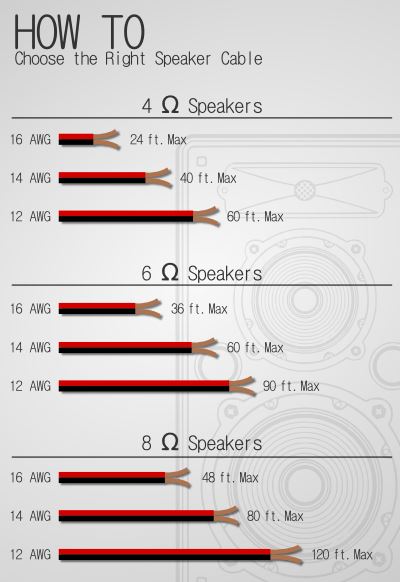A person may spend a fortune on a great set of speakers only to have the sound quality ruined by bad cables. If you have a hard time believing this, you’re not alone. Cables often get overlooked when setting up a speaker system. After all, if you buy great speakers do the cables really matter? The answer: yes, it matters. Bad cable equals bad sound. The most important thing to think about is AWG (American Wire Guage). Getting the wrong AWG for your speaker setup can end up giving you horrible sound quality. But AWG isn't the only thing to think about, let's take a look at what makes good quality cable.
AWG
When deciding what kind of cable to use for your speaker setup, one of the first things to consider is the cable’s AWG (American Wire Gauge). The AWG refers to the thickness of the copper wire in the cable. The lower the gauge number, the thicker the wire. Most speaker wire ranges from 12 AWG to 16 AWG. It’s important to use the correct gauge for your speaker setup.
When you buy speakers, watts are a big deal. But when you are looking for speaker cable, what you need to worry about is the speaker’s impedance. If you choose your cable based on length and your speaker’s impedance, the cable will be able to handle the speaker’s watt output just fine. So what is impedance? Impedance refers to the property the speaker has to add resistance to electrical current. Think of a garden hose with water flowing through it. Putting a nozzle on the end of the hose adds resistance to the flow of water.
In a speaker setup, the speaker is like the nozzle of the hose, it adds resistance to the electrical current running through the wires. A speaker’s impedance is measured in ohms. Most speakers have impedance ratings of 4, 8, or 16 ohms. But that number is more like an average. So if a speaker has an impedance rating of 4 ohms, it may vary between 2 ohms and 8 ohms during use. It’s important to choose a wire that can handle your speaker’s impedance. Otherwise you risk distorting your sound and possibly damaging your equipment.
That brings us to length. Length is a big factor in deciding what gauge wire to use. For longer lengths of cable, you may consider using a thicker wire. For most average speakers 16 AWG wire will work well for you in lengths of less than 50 ft. For longer runs or for higher end speakers, you probably want thicker wire. Below is a chart to help you match your speaker with the best cable thickness and length.
Pure Copper
Gauge isn’t the only thing to consider when you buy speaker cable. You also want to know what the cable is made of. Copper is the standard by which other electrical materials are rated. Other metals such as aluminum, zinc, and nickel are less conductive, but they are also usually cheaper. To cut down on cost, some cables are made with alloys mixed into the copper. While the percentage is relatively low, it still makes the wire significantly less conductive. Less conductive wire means poor sound quality. Adding in different alloys can also lead to cable breaks when going around tight corners. Pure copper cable might be a little bit more expensive, but it is definitely worth it in the long run.
Oxygen-Free
When dealing with copper, oxygen is bad news. Poor quality wire sometimes has microscopic pockets of oxygen trapped in the copper. Over time, these pockets can become larger and cause oxidation, which can make the copper less conductive, and may even destroy the cable. If you need your cable to last a while, make sure you look for oxygen-free cable.
Marked for Easy Installation
Okay, so this isn't strictly essential, but it can make your life easier. Ideally, the cables running to paired speakers should be the same length. That could mean a lot of measuring. Luckily, most cable comes marked on the jacket at every foot mark, making it easier to get just the right length before you cut.
AWG is the most critical thing to consider when buying speaker cable, but what the cable is made of is also important. Oxygen-free pure copper wire will give you better sound, and it will last longer than cheaper speaker cable. Now, get out there and make you're home theater awesome!
Speaker Wire Basics
Speaker wire consists of two or more electrical conductors, insulated by plastic (typically PVC, PE, or Teflon.) Electrically, the 2 wires are identical, but they are marked differently to ensure the correct polarity in installation. The wires are often marked by a ridge on the insulation of one wire, or the color of the wires (usually black and red). For added protection, some speaker wire features a 2nd plastic jacket to more thoroughly protect against kinks and cuts; it also makes it easier to pull wire behind walls and ceilings.
Selecting Speaker Wire
The quality of speaker wire varies greatly from brand to brand; from the purity of the metal wire (typically copper) to the quality of the jacketing. The more pure the copper wire the more consistent the conductive properties through the length of the wire it will be. Some jackets are less reactive to the interior conductor, easier to pull through walls and ceilings in industrial applications, and may feature multiple jackets for better protection against kinks and cuts.
Above all other features of speaker wire, the most important specification to look at is the wire’s resistance. If the resistance of a wire is too high, it can have an audible effect on the audio being transferred. To ensure a lower resistance, look for thicker wire gauge.


Wire Gauge
Wire gauge is measured by a unit called AWG (American Wire Gauge) where the lower the number the thicker the wire. Speaker wire typically is available in even increments between 22 AWG and 10 AWG; where 22 AWG is the smallest and 10 AWG is the biggest. With thicker wires, the resistance of the cable is reduced, allowing you to run cable in longer lengths than you would be able to with thinner wire.
Sewell Brand Speaker Wire
After doing all the research we’ve developed speaker wire that will work best for almost every application, at a lower price. Sewell speaker wire is made with 12 AWG copper-the 2nd thickest wire available, for the best value among low resistance cable. The 2 layers of insulation is great for both industrial and home use, protecting the copper conductors from kinks and cuts. We’re confident that Sewell speaker wire is the best value around.





